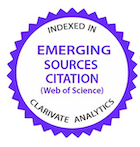PCR fluorescente associada à eletroforese capilar como ferramenta de diagnóstico de bactérias no semen
DOI:
https://doi.org/10.5216/cab.v14i3.7638Palavras-chave:
sêmen bovino, Brucella abortus, PCR fluorescente, Eletroforese capilar, diagnóstico.Resumo
Este estudo avaliou o limiar de detecção da técnica de PCR aliada à eletroforese capilar para diagnóstico da Brucella abortus em sêmen bovino. Doses inseminantes livres de patógenos foram contaminadas experimentalmente com B. abortus em escalas que variavam de 100 a 107 bactérias/mL e submetidas à extração de DNA pelo método de fenol/clorofórmio. A amplificação por PCR foi realizada utilizando-se oligonucleotídeos iniciadores, previamente descritos na literatura, BF–5’gcgctcaggctgccgacgcaa3’ (cromóforo FAM) e BR–5’accagccattgcggtcggta3’ para B. abortus.) Os pares de oligonucleotídeos geraram fragmentos de 193 pb. Após PCR, a visualização dos fragmentos foi realizada em gel de acrilamida 8% corada pela prata e por eletroforese capilar fluorescente em equipamento automático de análise de fragmentos de DNA. A detecção de DNA de B. abortus em sêmen bovino através de eletroforese capilar fluorescente foi possível a partir de concentração de 103 bactérias/mL, enquanto que em gel de poliacrilamida 8% o limite de detecção foi de 105 bactérias/mL. A eletroforese capilar demonstrou ser uma alternativa rápida, eficaz e de alta sensibilidade na detecção de DNA de Brucella em sêmen bovino, podendo ser uma valiosa ferramenta para a avaliação da sanidade do rebanho e para o controle de qualidade do sêmen produzido em centrais de inseminação artificial.
ALAVRAS-CHAVE: Brucella abortus; diagnóstico; eletroforese capilar; PCR fluorescente; sêmen bovino.
Downloads
Downloads
Publicado
Como Citar
Edição
Seção
Licença
Copyright (c) 2013 Ciência Animal Brasileira / Brazilian Animal Science

Este trabalho está licenciado sob uma licença Creative Commons Attribution 4.0 International License.
Autores que publicam nesta revista concordam com os seguintes termos:
- Autores mantém os direitos autorais e concedem à revista o direito de primeira publicação, com o trabalho simultaneamente licenciado sob a Licença Creative Commons Attribution que permite o compartilhamento do trabalho com reconhecimento da autoria e publicação inicial nesta revista.
- Autores têm autorização para assumir contratos adicionais separadamente, para distribuição não-exclusiva da versão do trabalho publicada nesta revista (ex.: publicar em repositório institucional ou como capítulo de livro), com reconhecimento de autoria e publicação inicial nesta revista.
- Autores têm permissão e são estimulados a publicar e distribuir seu trabalho online (ex.: em repositórios institucionais ou na sua página pessoal) a qualquer ponto antes ou durante o processo editorial, já que isso pode gerar alterações produtivas, bem como aumentar o impacto e a citação do trabalho publicado (Veja O Efeito do Acesso Livre).






























